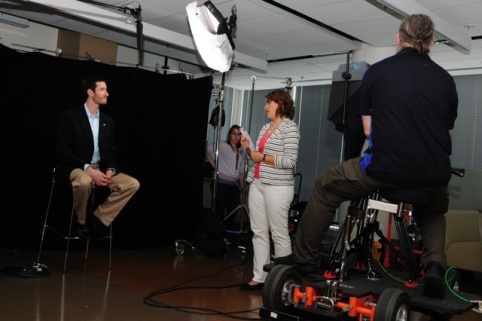In an episode of The Dick Van Dyke Show (“Boy #1, Boy #2,” CBS, 1965) Rob casts their son and one of his friends in an episode of his TV show. The results aren’t as anticipated. He confesses to the two moms: “Those kids can’t act, they’re terrible…When they started out they were almost fair, but the more they rehearsed the worse they got!” When the moms remind him the kids aren’t professionals, he responds “Yeah, because professionals get better!” So true. One of the big differences between trained and untrained talent is that repetition and self-consciousness about being in front of cameras and crew often degrades rather than enhances their “performance.” And each time you make your reality player self-conscious about the camera, chances are high they will be less natural—the very reason you wanted them in the first place. This, in turn, can radically affect your schedule and budget. In other chapters, we address specific techniques for re-introducing a question during an interview, for blocking a re-enactment, or getting that scene from another angle for a documentary, all without making your subject feel awkward. To keep your production schedule and budget on target, you need all the help you can get to minimize retakes and set-ups. Even if you are masterful at keeping your subject from feeling pressure during the shoot, every minute you spend in shoot planning will be paid back in decreased time and costs on the post-production side. Since you never entirely know how a “real person” will react to being on camera, the following are some strategies you can use to minimize unpleasant surprises and budget-busting problems, while you maximize creative opportunities.
- Be sure you discuss options for on-camera clothing before the shoot. Bring extra ties on set. If green-screen, be sure your subject is not wearing any green!
- Have enough crew. A production assistant is worth their weight in gold to help move gear in place quickly, or handle the back-end of recording remotely. Non-actors are not used to the “hurry up and wait” pattern of production life.
- Give non-actors a break by shooting b-roll. I often shoot a little bit of b-roll to warm them up to the crew, before sitting the person down for an interview.
- Use Locations Familiar to Subject to help them be more comfortable. If you need to move objects around for a better background, ask permission. (You may need to have the person themselves move things around for remote interviews.)
Excerpted from my book “The Producer’s Playbook: Real People on Camera”. I love directing “real people” on camera. Please sign up for my additional tips ——–> see sidebar!


 So-called “real people” can add power to a video story. For testimonials, someone who actually uses the product can be compelling. If the story focuses on a charity, someone who has lived the day-to-day impact can help raise funds more effectively than an on-camera professional host. A person who works in an organization might be the very best at explaining a new process or tool.
So-called “real people” can add power to a video story. For testimonials, someone who actually uses the product can be compelling. If the story focuses on a charity, someone who has lived the day-to-day impact can help raise funds more effectively than an on-camera professional host. A person who works in an organization might be the very best at explaining a new process or tool. It happens more often than we’d all like to admit that inexperienced speakers are selected to deliver important information directly to the camera. Whether they are the head of a department, the leader of an initiative, an enthusiastic volunteer, or the child of the executive producer, this person might not be all that comfortable with a teleprompter, or might not work with cameras and crews every day the way professionals do. That doesn’t mean you can’t direct a confident delivery. But your approach will need to differ from how you’d work with an actor or an experienced on-camera speaker.
It happens more often than we’d all like to admit that inexperienced speakers are selected to deliver important information directly to the camera. Whether they are the head of a department, the leader of an initiative, an enthusiastic volunteer, or the child of the executive producer, this person might not be all that comfortable with a teleprompter, or might not work with cameras and crews every day the way professionals do. That doesn’t mean you can’t direct a confident delivery. But your approach will need to differ from how you’d work with an actor or an experienced on-camera speaker.


